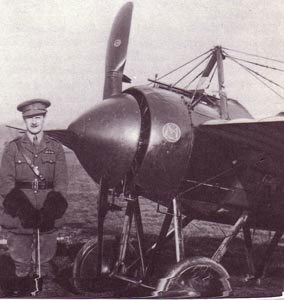
Garros deflector system. Bullets which struck the propellor were deflected by steel plates.
BOUNCING BULLETS
A Morane monoplane displays metal plates on its propeller blades. When its machine gun fired, about one in ten bullets hit the deflectors, bouncing off. This poster shows a German ace in an Eindecker firing through his propeller. The image captures the essence of the solo fighter pilot – the welding of man and aircraft into a single fighting machine.
Closeup of the Foster mounting installation of a Lewis machine gun on an S.E.5a; the gun can be slid back down the curved rail for upward firing and to reload the gun’s circular pan magazine.
WING-MOUNTED GUN
A Lewis Aerial Gun mounted on the top wing allowed pilots to shoot in the line of flight, over the propeller. The gun was fired by pulling on a cord that led down into the cockpit. The pilot’s problem with this arrangement was changing the ammunition drum in flight, a perilous moment requiring him to take his hands off the controls.
For the generals, the main reason for putting guns in aircraft was to protect their own reconnaissance aircraft and shoot down the enemy’s. But the initial impetus towards arming aircraft came from pilots and observers who simply wanted to “have a go” at the opposition. Firing pistols and carbines at passing aircraft had limited effect, while attempts at dropping grenades on them from above were a total failure. Machine guns were what were needed. But carrying such a weapon was a considerable burden for the lightweight, underpowered aircraft of 1914. It was also hazardous: there was a serious risk of blowing bits off your own machine, with its array of struts and wires. The first recorded aerial victory is credited to a French aviator. On 5 October 1914, observer Louis Quénault shot down an Aviatik with a Hotchkiss machine gun mounted on a Voisin 8 – a pusher aircraft (with the propeller at the rear). Affording a clear field of fire to the front, pushers were one option for air-combat machines. They proved especially attractive to the British, who introduced the Vickers “Gun bus” in 1915 and the F.E.2 and single-seat D.H.2 pushers the following year. But while pusher machines were by no means ineffective, tractor machines (propeller at the front) were faster and more manoeuvrable.
What the more skilful and adventurous pilots instinctively yearned for was a gun they could aim simply by pointing their aircraft at the target. Before the war, French and German designers had discovered that it was feasible to create an interrupter gear that would pause a machine gun each time a propeller blade was in its line of fire. Raymond Saulnier, designer of the Morane-Saulnier monoplane, was one of those who experimented with interrupters, but he had not been able to make one work in practice. So it was Dutch designer Anthony Fokker who fitted the first effective interrupter gear to one of his Eindecker monoplanes. The Germans went on to use guns firing through the propeller arc on all their fighters for the rest of the war. Interrupter gears and other forms of synchronizing mechanism tended to reduce the rate of fire of the machine gun, but in later German aircraft, such as the Albatros D.V and Fokker D.VII, the use of twin guns compensated for this drawback.
The Allies’ first effective riposte to the Eindecker’s interrupter gear was to mount a machine gun on the upper wing of a biplane so that it fired over the top of the propeller. Even after the Allies developed their own synchronizing mechanisms to allow firing through the propeller arc, they remained attached to the concept of the wing-mounted gun. Successful solo fighters such as the Nieuport 17 and the S.E.5a were usually fitted with both. In tandem with new armaments, new tactics were also being developed.
Early in the war individual fighters prowled the skies as lone hunters in search of unsuspecting enemy aircraft. By 1916, fighter aircraft were being grouped in squadrons as tactics were developed for fighting in formation. During the titanic battles of Verdun and the Somme, Allied and German airmen fought for air superiority; losses on both sides were heavy in an aerial combat that mirrored the war of attrition on the ground. Numerically inferior, the German aircraft tended to stay on their own side of the trenches and concentrate their resources in ever larger units capable of winning local air superiority on crucial sectors of the front.